 W
WAdobe is a building material made from earth and organic materials. Adobe is Spanish for 'mudbrick', but in some English-speaking regions of Spanish heritage the term is used to refer to any kind of earthen construction. Most adobe buildings are similar in appearance to cob and rammed earth buildings. Adobe is among the earliest building materials, and is used throughout the world.
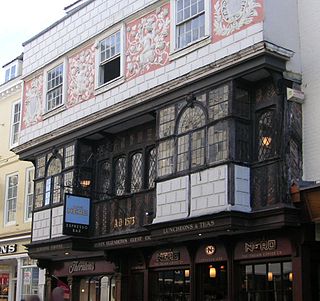 W
WArchitectural glass is glass that is used as a building material. It is most typically used as transparent glazing material in the building envelope, including windows in the external walls. Glass is also used for internal partitions and as an architectural feature. When used in buildings, glass is often of a safety type, which include reinforced, toughened and laminated glasses.
 W
WArchitectural terracotta refers to a fired mixture of clay and water that can be used in a non-structural, semi-structural, or structural capacity on the exterior or interior of a building. Terracotta pottery, as earthenware is called when not used for vessels, is an ancient building material that translates from Latin as "baked earth". Some architectural terracotta is actually the stronger stoneware. It can be unglazed, painted, slip glazed, or glazed. A piece of terracotta is composed of a hollow clay web enclosing a void space or cell. The cell can be installed in compression with mortar or hung with metal anchors. All cells are partially backfilled with mortar.
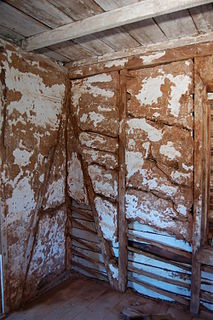 W
WBousillage is a mixture of clay and grass or other fibrous substances used as the infill (chinking) between the timbers of a half-timbered building. This material was commonly used by 18th-century French colonial settlers in the historical New France region of the United States and is similar to the material cob and adobe. In French torchis has the same meaning or the meaning of a loaf of this material.
 W
WA brick is a type of block used to build walls, pavements and other elements in masonry construction. Properly, the term brick denotes a block composed of dried clay, but is now also used informally to denote other chemically cured construction blocks. Bricks can be joined together using mortar, adhesives or by interlocking them. Bricks are produced in numerous classes, types, materials, and sizes which vary with region and time period, and are produced in bulk quantities.
 W
WClay is a type of fine-grained natural soil material containing clay minerals. Clays develop plasticity when wet, due to a molecular film of water surrounding the clay particles, but become hard, brittle and non–plastic upon drying or firing. Most pure clay minerals are white or light-coloured, but natural clays show a variety of colours from impurities, such as a reddish or brownish colour from small amounts of iron oxide.
 W
WCob, cobb or clom is a natural building material made from subsoil, water, fibrous organic material, and sometimes lime. The contents of subsoil naturally vary, and if it does not contain the right mixture it can be modified with sand or clay. Cob is fireproof, resistant to seismic activity, and uses low-cost materials, although it is very labour intensive. It can be used to create artistic and sculptural forms, and its use has been revived in recent years by the natural building and sustainability movements.
 W
WA compressed earth block (CEB), also known as a pressed earth block or a compressed soil block, is a building material made primarily from damp soil compressed at high pressure to form blocks. Compressed earth blocks use a mechanical press to form blocks out of an appropriate mix of fairly dry inorganic subsoil, non-expansive clay and aggregate. If the blocks are stabilized with a chemical binder such as Portland cement they are called compressed stabilized earth block (CSEB) or stabilized earth block (SEB). Typically, around 3,000 psi (21 MPa) is applied in compression, and the original soil volume is reduced by about half.
 W
WA concrete masonry unit (CMU) is a standard size rectangular block used in building construction. CMUs are some of the most versatile building products available because of the wide variety of appearances that can be achieved using them.
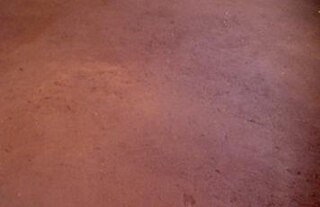 W
WAn earthen floor, also called an adobe floor, is a floor made of dirt, raw earth, or other unworked ground materials. It is usually constructed, in modern times, with a mixture of sand, finely chopped straw and clay, mixed to a thickened consistency and spread with a trowel on a sub-surface such as concrete. Once dry, it is then usually saturated with several treatments of a drying oil.
 W
WLightweight expanded clay aggregate (LECA) or expanded clay (exclay) is a lightweight aggregate made by heating clay to around 1,200 °C (2,190 °F) in a rotary kiln. The yielding gases expand the clay by thousands of small bubbles forming during heating producing a honeycomb structure. LECA has an approximately round or potato shape due to circular movement in the kiln and is available in different sizes and densities. LECA is used to make lightweight concrete products and other uses.
 W
WFerrocement or ferro-cement is a system of construction using reinforced mortar or plaster applied over an "armature" of metal mesh, woven expanded-metal or metal-fibers and closely spaced thin steel rods such as rebar. The metal commonly used is iron or some type of steel, and the mesh is made with wire with a diameter between 0.5 mm and 1 mm. The cement is typically a very rich mix of sand and cement in a 3:1 ratio; and when used for making boards no gravel is used, so that the material is not concrete.
 W
WGravel is a loose aggregation of rock fragments. Gravel is classified by particle size range and includes size classes from granule- to boulder-sized fragments. In the Udden-Wentworth scale gravel is categorized into granular gravel and pebble gravel. ISO 14688 grades gravels as fine, medium, and coarse with ranges 2 mm to 6.3 mm to 20 mm to 63 mm. One cubic metre of gravel typically weighs about 1,800 kg.
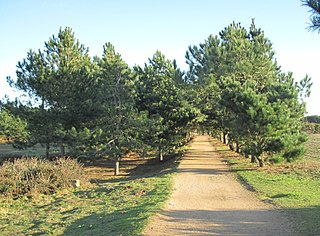 W
WHoggin is a compactable groundcover that is composed of a mixture of clay, gravel, and sand or granite dust that produces a buff-coloured bound surface. It is more commonly seen in the south of England and at National Trust properties. The material is aesthetically suited to older properties and is lower maintenance than gravel alone since it does not need regular raking. Once laid, the surface is somewhat permeable to water and therefore does not easily hold puddles or generate rapid surface runoff. The material is increasingly being used at domestic properties as a low cost and environmentally friendly alternative to concrete and block paving in paths and driveways.
 W
WLaterite is both a soil and a rock type rich in iron and aluminum and is commonly considered to have formed in hot and wet tropical areas. Nearly all laterites are of rusty-red coloration, because of high iron oxide content. They develop by intensive and prolonged weathering of the underlying parent rock. Tropical weathering (laterization) is a prolonged process of chemical weathering which produces a wide variety in the thickness, grade, chemistry and ore mineralogy of the resulting soils. The majority of the land area containing laterites is between the tropics of Cancer and Capricorn.
 W
WLight clay is a natural building material used to infill between a wooden frame in a timber framed building using a combination of clay and straw, woodchips or some other lighter material.
 W
WA limepit is either a place where limestone is quarried, or a man-made pit used to burn lime stones in the same way that modern-day kilns and furnaces constructed of brick are now used above ground for the calcination of limestone and by which quicklime is produced, an essential component in waterproofing and in wall plastering.
 W
WMangalore tiles are a type of tile native to the city of Mangalore, India. Typically considered to be a part of Spanish and Italian architectural styles, the tiles were first introduced to India in 1860 by a German missionary. Since that time, the industry has flourished in India with these red tiles, prepared from hard laterite clay, in great demand throughout the country. They are exported to Myanmar, Sri Lanka, and the Far East and even as far as East Africa, the Middle East, Europe, and Australia. These were the only tiles recommended for government buildings in India under the British Raj.
 W
WMortar is a workable paste which hardens to bind building blocks such as stones, bricks, and concrete masonry units, to fill and seal the irregular gaps between them, spread the weight of them evenly, and sometimes to add decorative colors or patterns to masonry walls. In its broadest sense, mortar includes pitch, asphalt, and soft mud or clay, as used between mud bricks. The word "mortar" comes from Latin mortarium, meaning crushed.
 W
WMud is soil, loam, silt or clay mixed with water. It usually forms after rainfall or near water sources. Ancient mud deposits harden over geological time to form sedimentary rock such as shale or mudstone. When geological deposits of mud are formed in estuaries, the resultant layers are termed bay muds.
 W
WA mudbrick or mud-brick is an air-dried brick, made of a mixture of loam, mud, sand and water mixed with a binding material such as rice husks or straw. Mudbricks are known from 9000 BCE, though since 4000 BC, bricks have also been fired, to increase their strength and durability.
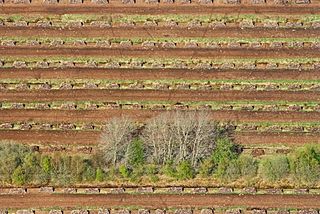 W
WPeat, sometimes known as turf, is an accumulation of partially decayed vegetation or organic matter. It is unique to natural areas called peatlands, bogs, mires, moors, or muskegs. The peatland ecosystem covers 3.7 million square kilometres (1.4 million square miles) and is the most efficient carbon sink on the planet, because peatland plants capture CO2 naturally released from the peat, maintaining an equilibrium. In natural peatlands, the "annual rate of biomass production is greater than the rate of decomposition", but it takes "thousands of years for peatlands to develop the deposits of 1.5 to 2.3 m [4.9 to 7.5 ft], which is the average depth of the boreal [northern] peatlands", which store around 415 gigatonnes (457 billion short tons; 408 billion long tons) of carbon (about 46 times 2019 global CO2 emissions). Globally, it even stores up to 550 gigatonnes (610 billion short tons; 540 billion long tons) of carbon, representing 42% of all soil carbon and exceeds the carbon stored in all other vegetation types, including the world's forests. Across the world, peat covers just 3% of the land’s surface, but stores one-third of the Earth’s soil carbon. Sphagnum moss, also called peat moss, is one of the most common components in peat, although many other plants can contribute. The biological features of sphagnum mosses act to create a habitat aiding peat formation, a phenomenon termed 'habitat manipulation'. Soils consisting primarily of peat are known as histosols. Peat forms in wetland conditions, where flooding or stagnant water obstructs the flow of oxygen from the atmosphere, slowing the rate of decomposition.
 W
WPuddling is both the material and the process of lining a water body such as a channel or pond with puddle clay – a watertight material based on clay and water mixed to be workable.
 W
WRammed earth, also known as taipa in Portuguese, tapial or tapia in Spanish, tàpia in Catalan, pisé in French, bijenica in Serbian, and hāngtǔ (夯土) in Mandarin Chinese, is a technique for constructing foundations, floors, and walls using natural raw materials such as earth, chalk, lime, or gravel. It is an ancient method that has been revived recently as a sustainable building method.
 W
WSand is a granular material composed of finely divided rock and mineral particles. Sand has various compositions but is defined by its grain size. Sand grains are smaller than gravel and coarser than silt. Sand can also refer to a textural class of soil or soil type; i.e., a soil containing more than 85 percent sand-sized particles by mass.
 W
WA sandbag or dirtbag is a bag or sack made of hessian (burlap), polypropylene or other sturdy materials that is filled with sand or soil and used for such purposes as flood control, military fortification in trenches and bunkers, shielding glass windows in war zones, ballast, counterweight, and in other applications requiring mobile fortification, such as adding improvised additional protection to armoured vehicles or tanks.
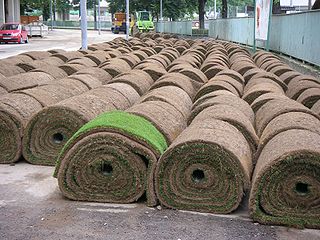 W
WSod also known as turf is grass. When harvested into rolls it is held together by its roots and a thin layer of soil.
 W
WStructural Soil is a medium that can be compacted to pavement design and installation requirements while permitting root growth. It is a mixture of gap-graded gravels and soil. It provides an integrated, root penetrable, high strength pavement system that shifts design away from individual tree pits.
 W
WSuperadobe is a form of earthbag construction that was developed by Iranian architect Nader Khalili. The technique uses layered long fabric tubes or bags filled with adobe to form a compression structure. The resulting beehive-shaped structures employ corbelled arches, corbelled domes, and vaults to create sturdy single and double-curved shells. It has received growing interest for the past two decades in the natural building and sustainability movements.
 W
WWattle and daub is a composite building method used for making walls and buildings, in which a woven lattice of wooden strips called wattle is daubed with a sticky material usually made of some combination of wet soil, clay, sand, animal dung and straw. Wattle and daub has been used for at least 6,000 years and is still an important construction method in many parts of the world. Many historic buildings include wattle and daub construction, and the technique is becoming popular again in more developed areas as a low-impact sustainable building technique.